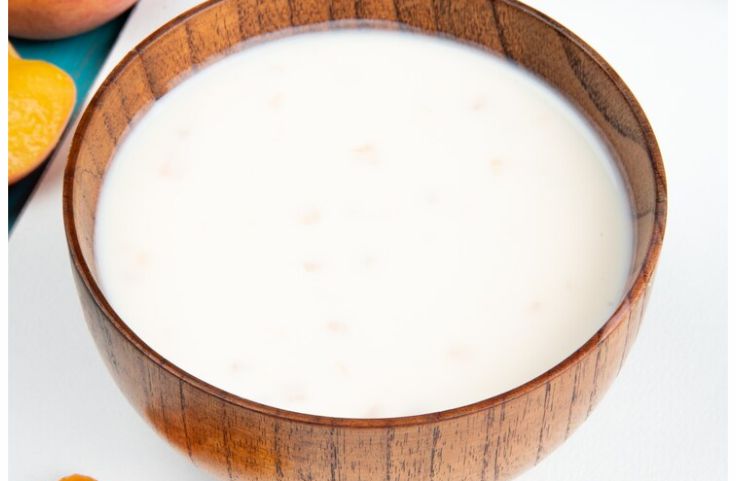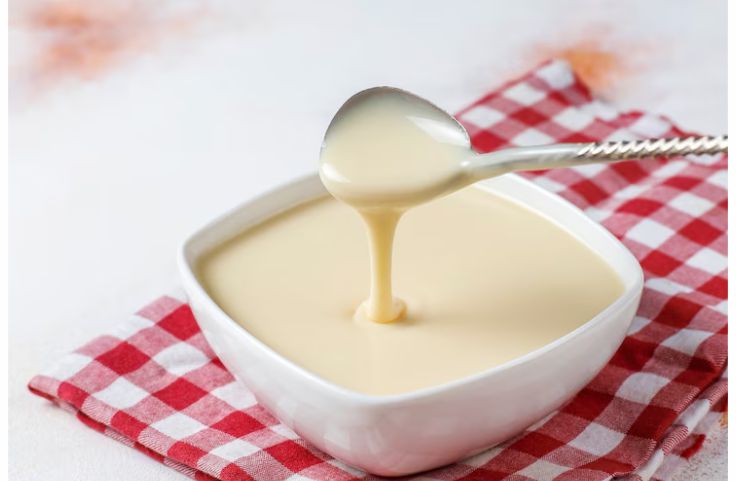Filipino cassava pie brings the perfect blend of creamy coconut, sweet condensed milk, and chewy cassava, just like the ones baked fresh in every Pinoy home celebration.
Filipino cassava pie takes you straight to the heart of a Filipino gathering.
You’ll find it on the table during birthdays, holidays, or Sunday lunches with family.
It’s soft, creamy, and just the right amount of sweet. Made with grated cassava or kamoteng kahoy, mixed with coconut milk, condensed milk, and eggs, it bakes into a rich, chewy dessert that leaves a lasting impression.
The golden top adds a subtle caramel flavor that balances every bite.
If you’ve had cassava cake before, this version brings a homemade warmth that’s hard to miss.
It’s more than a recipe, it’s comfort food rooted in tradition. As you prepare it, you’re not just baking.
You’re connecting with a flavor passed through generations. Ready to bring that warm, nostalgic taste into your kitchen? Want to know more about pies? See the cassava pie resource.
Let’s get started.
Table of Contents
- What is Filipino Cassava Pie by the Way?
- What Makes Filipino Cassava Pie Special
- Ingredients for Filipino Cassava Pie Recipe
- How to Make Filipino Cassava Pie
- Tips for the Best Cassava Pie
- Filipino Cassava Pie vs Other Variations
- Serving Suggestions
- Common Mistakes to Avoid
- Frequently Asked Questions
- Conclusion
What is Filipino Cassava Pie by the Way?
Filipino cassava pie is a sweet, baked dessert made with grated cassava, coconut milk, sugar, and eggs. It’s known for its creamy texture and rich coconut flavor, often served during family gatherings and holidays.
Unlike cassava cakes that are denser, this pie has a smoother filling and may include toppings like grated cheese or macapuno strings.
It reflects the heart of Filipino home baking, simple ingredients, bold flavors, and comforting results.
What Makes Filipino Cassava Pie Special
Filipino cassava pie brings more than flavor to the table. It connects you to tradition, memory, and the simple joy of sharing a homemade dessert with the people around you.
Cassava: The Heart of the Pie
You start with cassava or kamoteng kahoy, a root crop that’s easy to find across the Philippines.
It’s grated and mixed into the batter, giving the pie its chewy base and subtle earthiness. More on freshly grated or frozen cassava here.
Cassava holds up well during baking, creating a soft and firm texture you’ll love.
It’s more than a filler; it gives body to the dessert and plays a big role in many Filipino recipes, especially local snacks and sweets.
Coconut Milk: Flavor and Comfort
Coconut milk brings warmth to every bite. As you stir it into the mixture, it softens the cassava and adds a creamy finish.
The coconut flavor ties back to many traditional Filipino desserts, from biko to ginataang bilo-bilo.
You’re not just adding richness, you’re using an ingredient that reflects the tropical roots of Filipino cooking.
Some versions even add grated coconut for texture.
Condensed Milk: Sweetness You Remember
You’ll recognize the sweetness right away. Condensed milk blends into the batter, giving it a smooth, sugary taste that balances the starchiness of the cassava.
It browns beautifully on top when baked, adding a golden layer that’s just slightly crisp.
That contrast, chewy inside, caramelized top, is what keeps people coming back.
This dessert speaks the language of comfort and memory in every slice.
Tradition: Passed from One Table to Another
When you serve cassava pie, you’re continuing something that started long before you.
It shows up during fiestas, holidays, and family reunions. Some recipes stay the same for decades, passed down from one cook to the next.
That’s part of what makes it special. You’re not just making dessert, you’re keeping a piece of home alive, no matter where you are.
Related Posts
- Cassava Pie Crust Recipe
- How to Make Bermudian Cassava Pie
- Boiled Cassava Root Recipe
- How to Make Tapioca Pearls
- Cassava-Based Recipes Around the World
- Trinidad Cassava Pie (Step-by-step)
- The Fiji Cassava Pie Recipe
Ingredients for Filipino Cassava Pie Recipe
Cassava: Your Base Ingredient

Grated cassava gives the pie its chewy texture and holds everything together.
Fresh is best, but frozen works just as well. Always rinse well to remove bitterness, especially with market-bought cassava.
Coconut Milk: Flavor from the Tropics

Coconut milk adds a creamy, fragrant base to cassava pie. Fresh offers a richer flavor, while canned is convenient.
It blends smoothly with cassava and balances sweetness with subtle earthy tones.
Condensed and Evaporated Milk: Sweet and Creamy

Condensed milk sweetens, evaporated milk smooths. Together, they create a moist, rich filling that bakes evenly.
Using familiar brands helps ensure the taste and texture stay true to tradition.
Butter and Eggs: Texture and Flavor

Butter boosts richness and color, while eggs help the pie set with a smooth finish.
Room-temperature eggs mix better, ensuring your cassava pie bakes firm without becoming dry.
Add-ins: Make It Your Own
Grated cheese adds saltiness, macapuno strings add chew, and vanilla gives warmth.
These extras personalize your cassava pie and make each slice more flavorful, without straying from its roots.
How to Make Filipino Cassava Pie
Baking your Filipino cassava pie is easier than you might think. With a few basic steps and familiar ingredients, you’ll bring a beloved Pinoy dessert straight to your kitchen.
Prepare the Oven and Baking Pan
Start by preheating your oven to 350°F or 175°C. While the oven heats, lightly grease a 9-inch round pan with butter or cooking oil.
This keeps the pie from sticking and helps you get a clean slice after baking.
Setting this up early makes the rest of the process smoother and keeps the pie from drying out on the edges.
Mix the Cassava and Coconut Milk
In a large bowl, combine your grated cassava and coconut milk. Stir them well until fully blended.
This mixture forms the base of your pie and sets the texture for the rest. If you’re using frozen cassava, make sure it’s fully thawed and drained.
The coconut milk brings creaminess and ties the flavor to classic Filipino desserts like cassava cake and biko.
Add Condensed Milk and Mix Until Smooth
Pour in the sweetened condensed milk and stir again. This step adds body and sweetness to the mixture.
Keep mixing until everything looks smooth and even. The batter should feel thick but pourable.
At this stage, you can already smell the familiar scent that brings you back to birthdays, holidays, or simple Sunday meals at home.
Beat the Eggs and Add the Rest
In a separate bowl, beat your eggs. Once ready, pour them into the cassava mixture.
Add sugar and a bit of vanilla extract if you like. Stir everything again until fully combined. You want the batter to be lump-free.
These final ingredients help hold the pie together and bring in just enough flavor to balance the cassava and milk.
Bake Until Firm and Golden
Pour the mixture into your greased pan and spread it out evenly. Place it in the preheated oven and bake for 45 to 50 minutes.
You’ll know it’s ready when the top turns golden and a toothpick in the center comes out clean.
If you want a little twist, sprinkle grated cheese or desiccated coconut during the last 10 minutes for added texture.
Cool Before Serving
Once baked, take the pie out and let it cool in the pan for about 10 to 15 minutes.
Then move it to a rack or tray to finish cooling. Letting it rest makes it easier to slice and brings out the full flavor.
Serve your cassava pie warm or chilled; either way, it’s a sweet taste of home.

Tips for the Best Cassava Pie
Making a satisfying Filipino cassava pie comes down to getting a few key things right.
From the texture of your batter to how you bake and store it, every step matters.
Keep the Batter Thick and Smooth
The texture of your batter affects everything. If it’s too wet, your pie will turn out soggy and flat.
Use fresh grated cassava and squeeze out any extra moisture. If you’re working with frozen cassava, thaw it completely and press out the water before using.
Aim for a batter that’s thick enough to hold shape but still mixes easily with milk and eggs.
Aim for a Golden Finish
To get that deep golden top you love, preheat your oven properly. Use a glass or ceramic baking dish for even heat.
Right before baking, brush the top of your pie with a simple egg wash mixed with a splash of milk.
Keep an eye on it toward the end so it browns without burning. That golden crust adds both flavor and a better bite.
Store It the Right Way
Let your cassava pie cool completely before storing. Wrap it in foil or plastic and keep it in the fridge.
This keeps the texture soft and the flavor fresh. When you’re ready to eat it again, place a slice in an oven-safe dish and reheat it at 350°F for about 10 to 15 minutes.
It will warm through without drying out and taste just as good as the first day.
Filipino Cassava Pie vs Other Variations
Filipino cassava pie stands out for its rich, creamy texture and use of coconut milk. Here’s how it compares with other well-known cassava-based desserts.
Filipino Cassava Pie vs Bermuda Cassava Pie
If you’ve tasted Bermuda’s version, you’ll notice the difference right away.
Bermuda cassava pie is dense, firm, and mildly sweet, usually served with meat during holidays.
Filipino cassava pie, on the other hand, is sweeter and creamier. It often includes condensed milk and coconut milk, making each bite smooth and comforting.
While Bermuda’s style skips the crust, the Filipino version gives you a soft filling with a golden top and sometimes a light crust.
Filipino Cassava Pie vs Cassava Cake
You might confuse cassava pie with cassava cake, but they serve different textures and moods.
Cassava cake is denser and chewier. It is usually topped with a thick layer of custard or butter, giving it a heavier finish.
Filipino cassava pie feels lighter on the tongue and richer in flavor.
The soft middle and sweet notes from the coconut milk make it more of a dessert pie than a cake.
Why Filipino Cassava Pie Feels More Like Home
There’s something nostalgic about Filipino cassava pie. From the smell of coconut in your kitchen to the golden brown top, it brings comfort and familiarity.
It’s a dessert that reminds you of family gatherings, birthdays, and quiet afternoons with coffee.
Its simple preparation and warm flavor make it more than just a dessert; it becomes part of your story.
Serving Suggestions
You can enjoy Filipino cassava pie in many ways, whether you’re sharing it at a family celebration or just treating yourself on a quiet afternoon.
These serving ideas help bring out its full flavor and texture.
Pair with Ice Cream for Contrast
Try serving your cassava pie warm with a scoop of vanilla or coconut ice cream on the side.
The hot and cold contrast creates a satisfying balance, especially with the pie’s chewy texture and creamy base.
It’s an easy way to impress guests or treat yourself to a dessert that feels both simple and special.
Top with Whipped Cream for Extra Creaminess
If you want a richer finish, add a spoonful of whipped cream on top of each slice.
It blends well with the soft coconut filling and gives every bite a smoother mouthfeel.
Whipped cream also helps lighten the overall taste if the pie feels a bit dense, making it a good match for both casual and more refined servings.
Add Fresh Fruit for a Bright Finish
Fresh fruits like mangoes, bananas, or strawberries can brighten up your cassava pie.
Their natural sweetness and juicy texture contrast well with the dense cassava.
You can serve them sliced on the side or layered over the top.
This works well for daytime events or when you want a lighter, colorful plate.
Drizzle with Honey or Fruit Sauce
For extra flavor, drizzle some honey or fruit compote over each serving.
The syrupy layer adds a subtle sweetness or tang, depending on what you use.
Try mango sauce, berry jam, or even a light caramel for something bolder.
This small touch can change the whole experience without overpowering the pie’s original taste.
Make It a Celebration Dessert
You don’t have to wait for a holiday to serve cassava pie, but it does shine during family gatherings and special events.
Its soft texture and familiar coconut flavor feel comforting and festive.
You can dress it up with toppings or keep it simple; it works either way. Just slice and serve, and let the pie do the rest.
Common Mistakes to Avoid
Making Filipino cassava pie is rewarding, but a few missteps can affect your results.
Here are simple fixes to avoid common issues and enjoy a pie that turns out just right.
Guessing Your Ingredient Measurements
Don’t eyeball your measurements. Cassava pie depends on the balance between cassava, coconut milk, and sugar.
Use a kitchen scale or proper measuring cups to stay consistent. Too much liquid can make the pie soggy, while too little can dry it out.
Taking time to measure everything correctly helps you avoid texture problems and keeps the flavor balanced in every slice.
Baking It for Too Little Time
If the top looks golden, that doesn’t mean it’s done inside. Cassava needs enough time to cook through fully.
A soft or jiggly center means you pulled it out too early. Stick to the recommended baking time, usually around 45 to 60 minutes, and use a toothpick to check the middle.
If it comes out clean, you can safely remove the pie and let it cool.
Covering It Before It Cools
Resist the urge to cover your cassava pie while it’s still warm. Doing so traps steam and makes the crust soggy.
Let it cool completely at room temperature before you store it. Once cool, place it in an airtight container and refrigerate.
This helps preserve its creamy texture and keeps it tasting fresh for days without losing its coconut flavor or structure.
Frequently Asked Questions
Can I use frozen cassava instead of fresh?
Yes, frozen cassava works well. Just thaw it fully and squeeze out excess moisture before mixing to keep the texture chewy and not soggy.
Is cassava pie the same as cassava cake?
No. Cassava pie is softer and creamier, while cassava cake is denser and topped with custard. Both use similar ingredients but feel very different.
Can I make cassava pie without condensed milk?
You can, but it will change the sweetness and texture. You might need to add sugar or use a milk alternative that blends well.
How long does cassava pie last in the fridge?
Cassava pie stays fresh in the fridge for up to five days. Keep it in an airtight container and reheat slices before serving for best results.
Conclusion
Filipino cassava pie is more than a sweet treat; it’s a warm invitation to share a slice of tradition.
Every bite carries the soft chew of cassava, the rich aroma of coconut milk, and the sweet depth of condensed milk.
Whether you’re making it for a holiday or a quiet Sunday, it brings comfort and connection to the table.
It’s easy to prepare and even easier to enjoy. From mixing the batter to watching it turn golden in the oven, the process feels just like home.
If you’re craving something heartfelt, familiar, and full of flavor, this Filipino favorite is the perfect pie to bake next.

Chimeremeze Emeh is a writer and researcher passionate about Africa’s most transformative root crop—cassava. Through his work at cassavavaluechain.com, he explores the entire cassava industry, from cultivation and processing to its diverse applications in food, health, and industrial use.
He also writes for palmoilpalm.com, where he shares his extensive experience and deep-rooted knowledge of palm oil, covering red palm oil, palm kernel oil, and refined products. His work there reflects his lifelong connection to agriculture and his commitment to promoting sustainable value chains in Africa.
Driven by curiosity and purpose, Chimeremeze aims to shed light on how cassava continues to empower communities, strengthen food systems, and link traditional farming wisdom with modern innovation.
